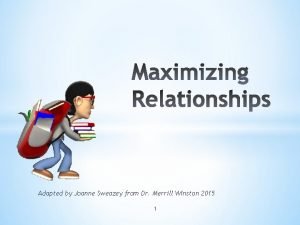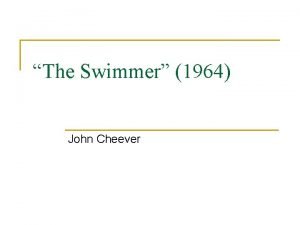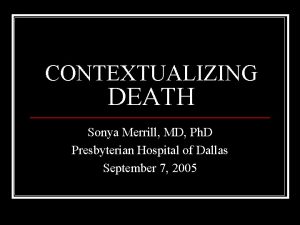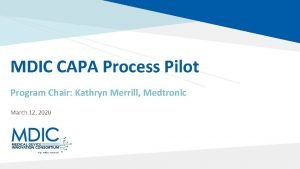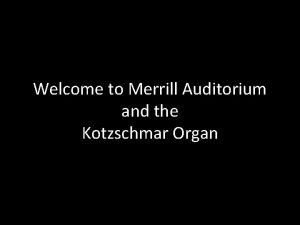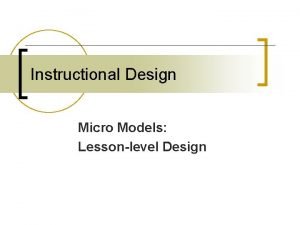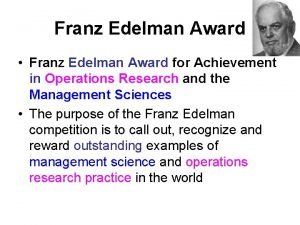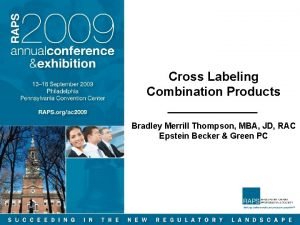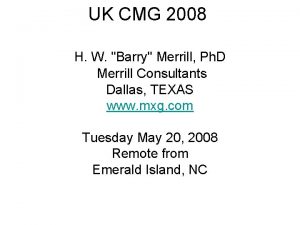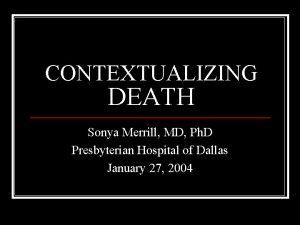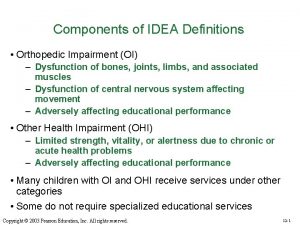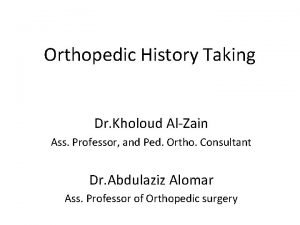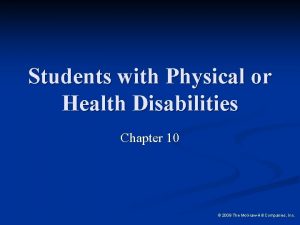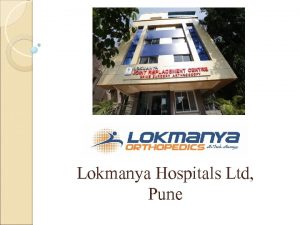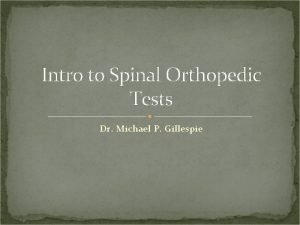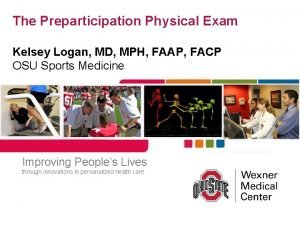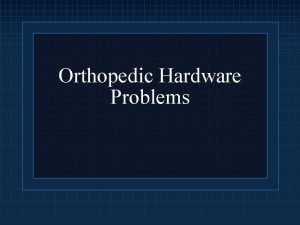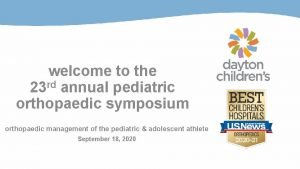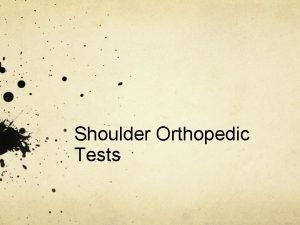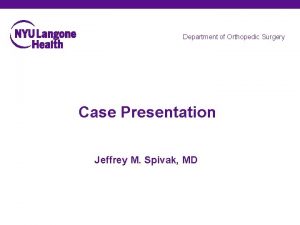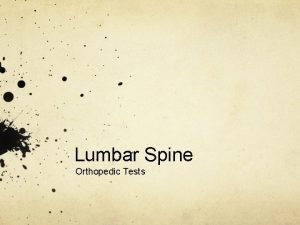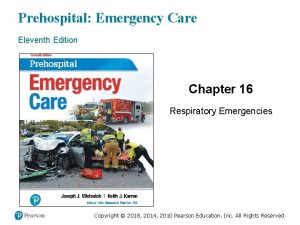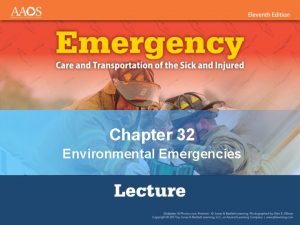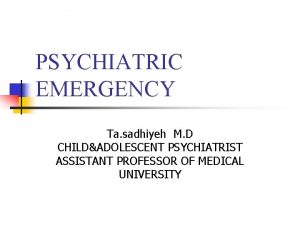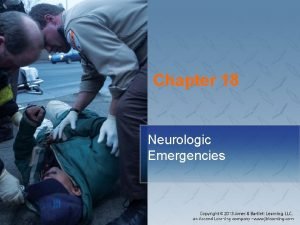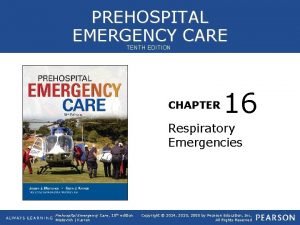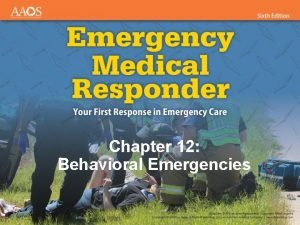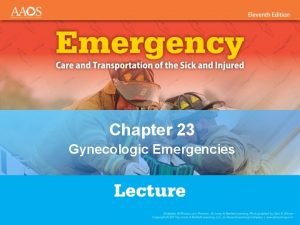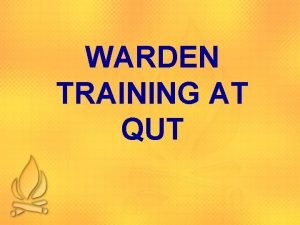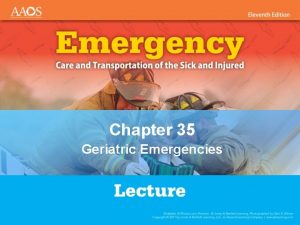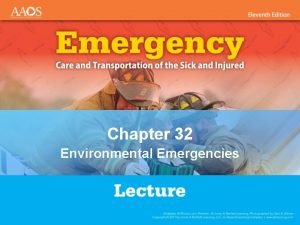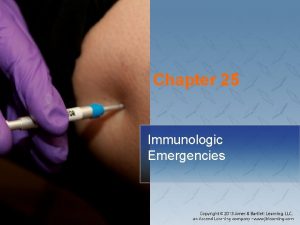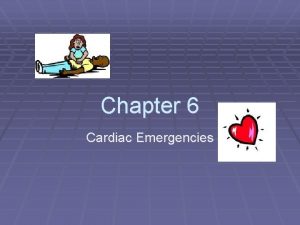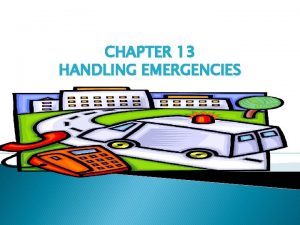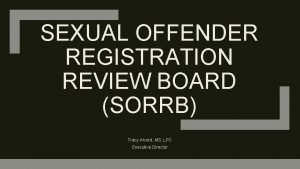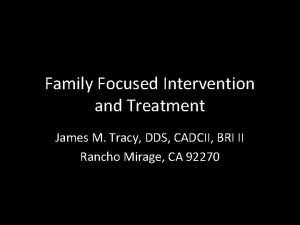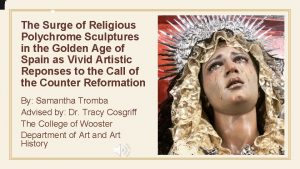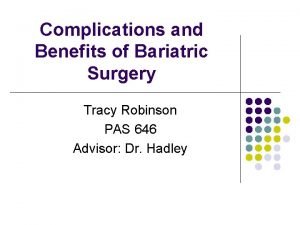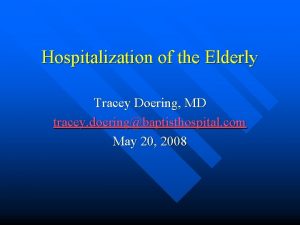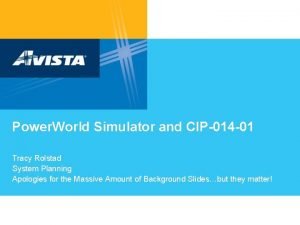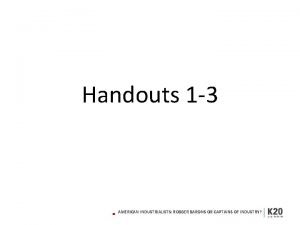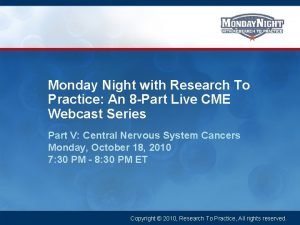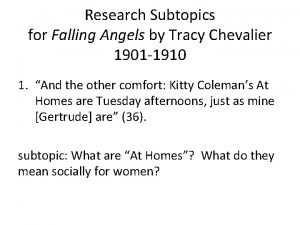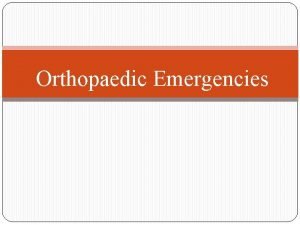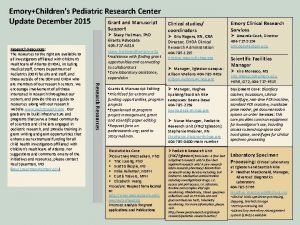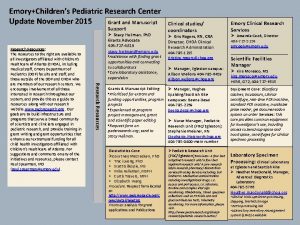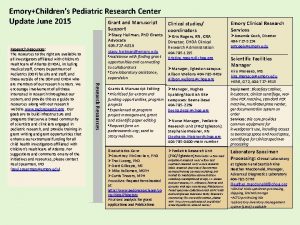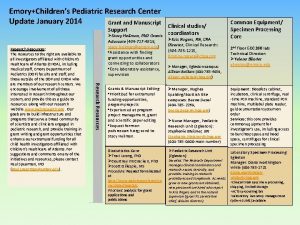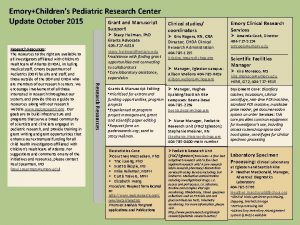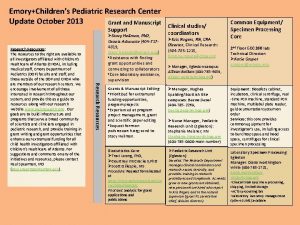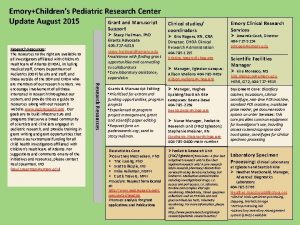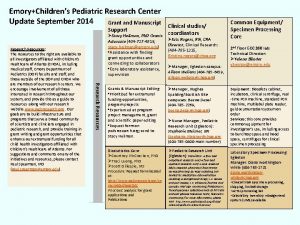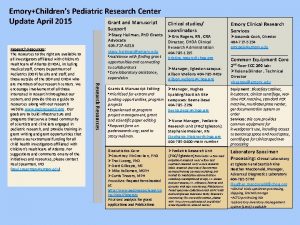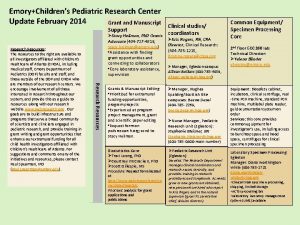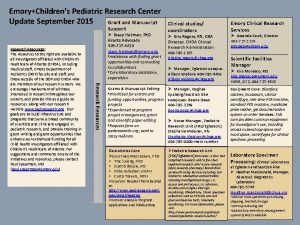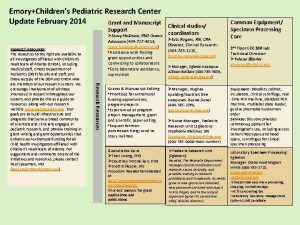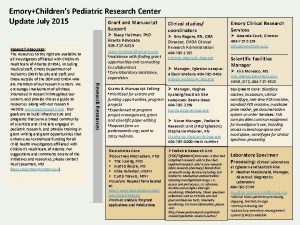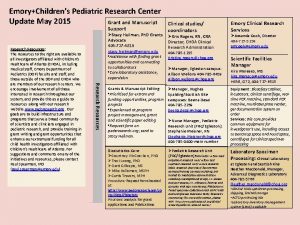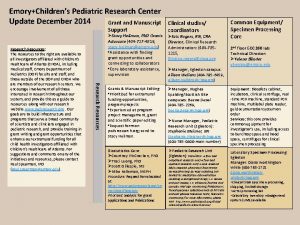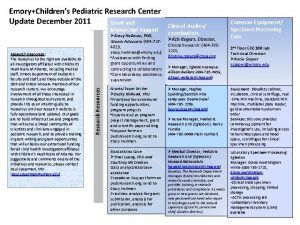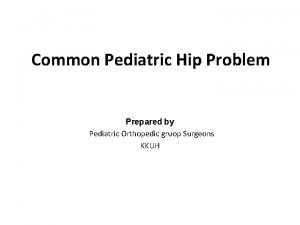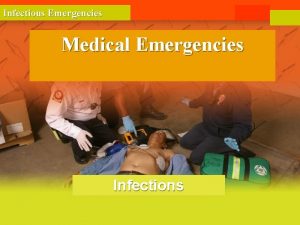EMORYChildrens Center Pediatric Orthopedic Emergencies Tracy Merrill MD















































































- Slides: 79

EMORY-Children’s Center Pediatric Orthopedic Emergencies Tracy Merrill MD Division of Pediatric Emergency Medicine Children’s Healthcare of Atlanta at Egleston and Emory University School of Medicine Use * † ‡ if there authors other than our group, using * to demark us, if its only us take out *

The Limping Child § 4 year old child presents to the emergency department with a chief complaint of limping for two days § No report of trauma § Afebrile § No additional systemic symptoms § PMH negative for joint problems or chronic disease § Nontender to palpation and no pain with passive ROM but limps when bears weight § Differential? § Workup? 2

Transient Synovitis - Definition § Also known as “irritable hip” or “toxic synovitis” § The #1 cause of acute hip pain in children § Benign self limited disease of uncertain etiology most commonly affecting the hip joint § Usually occurs in children age 3 to 10 years § 4 cases in adults have been reported § Almost always unilateral § Causes pain and limitation of the movement of the hip, with or without an effusion § Pain is the worst when walking, usually presents with a limp or refusal to bear weight 3

Transient Synovitis – Etiology, Treatment § Due to transient sterile inflammation of the synovium of the hip § No clear precipitants, ? post viral § Sudden onset, gradual resolution § Self limited, usually lasts 4 -7 days § Treated with OTC analgesics: ibuprofen and tylenol § Study done showed ibuprofen decreased median duration of symptoms from 4. 5 days to 2 days § No residual long term deficits § Most important thing to do is distinguish it from septic arthritis 4

Septic Arthritis - Definition § Results from bacterial invasion of the joint space § Can occur at any age but 50% of cases reported occur in children under the age of 3 years § Acute onset § Usually monoarticular § Usually the large peripheral joints § Organisms can invade the joint by three possible mechanisms: • Usually through hematogenous seeding • Adjacent osteomyelitis • Direct inoculation from a penetrating wound 5

Septic Arthritis - Bugs • Staphylococcus aureus • Streptococcus s GBS s S pneumoniae s S pyogenes • Neisseria gonorrhoeae • Haemophilus influenzae 6

Septic Arthritis - Presentation § Most commonly involves the hip joint “septic coxitis” § Symptoms include: • Fever • Joint pain • Limp and an inability to bear weight • Pain with active or passive range of motion • Joint swelling, effusion, warmth, tenderness § The patient holds their leg in a flexed, abducted, externally rotated position 7

Septic Arthritis - Presentation § May be extremely difficult to diagnose in infants and nonverbal children § Fever, irritability, and decreased po intake may be your only clues § May fuss more when handled due to movement of the affected extremity § May have decreased movement of an extremity § Predisposing factors include recent URI or otitis, skin or soft tissue infections, traumatic puncture wounds, femoral venipunctures, underlying chronic disease, or immunosuppression 8

Septic Arthritis - Differential § Differential can include: • Transient synovitis • Viral arthritis • Traumatic arthritis • Periarticular cellulitis • Osteomyelitis • JRA • Acute rheumatic fever (JONES criteria) • Lyme disease • Post-infectious reactive arthritis • Oncologic process (eg. leukemia, osteosarcoma) 9

Septic Arthritis - Diagnosis § Laboratory: s CBC with diff shows elevated white count with a left shift s Blood cultures are positive 40 -50% of the time s CRP elevated s ESR elevated s Joint aspiration shows elevated WBC’s 10, 000250, 000 (normal is less than 200), >75% segs, and decreased glucose § Imaging: • Plain films may show a displacement or blurring of periarticular fat pads as well as an increased hip joint space • MRI 10

Septic Arthritis - Diagnosis § Study done by Jung, et al. (2003*) found five predictors that correlated with a high probability of septic arthritis to help distinguish from transient synovitis whose presentation can be similar • Temperature >37 degrees Celsius (37. 7 vs. 36. 6) • WBC >11, 000/m. L (18. 2 vs. 8. 2) • CRP >1 mg/d. L (10. 1 vs. 0. 66) • ESR >20 mm/h (79. 2 vs. 20. 3) • Joint space difference >2 mm between the affected and unaffected sides (difference of 4. 0 mm vs. 1. 2 mm) • No significant difference found in platelet count 11

Septic Arthritis - Treatment § Treatment: • Prompt orthopedic consultation • Surgical debridement of the hip through arthrotomy • Hospitalization until fever defervescence and signs of clinical improvement post operatively • Intravenous antibiotics for 4 weeks • Usually requires central line placement for home administration of antibiotics 12

Septic Arthritis - Treatment § Antibiotic Therapy • <2 months of age: oxacillin or nafcillin plus gentamicin for Gram negatives • 2 months to 3 years: ampicillin-sulbactam or ceftriaxone • >3 years: oxacillin, nafcillin, or ceftriaxone • Adjust based on gram stain and culture results • Consider Clinda or Vanc if suspect MRSA 13

Septic Arthritis - Outcomes § Complications • Osteomyelitis, osteonecrosis • Avascular necrosis due to the pressure on blood vessels and cartilage in the femoral head area • Epiphyseal separation • Pathologic dislocation • Growth arrest and subsequent leg length discrepancies up to several inches • Sepsis 14

Septic Arthritis - Outcomes § Prognosis • Joint destruction can occur within days leading to longterm disability, residual deformity, arthritis, and decreased range of motion • Prior to the discovery of antibiotics, pediatric mortality rates averaged 50% • If diagnosed early before changes seen on plain films, have an improved prognosis • Note that joint destruction as a result of gonococcal infection is uncommon 15

SCFE: Slipped Capital Femoral Epiphysis 16 § An acquired growth plate injury § The separation of the proximal femoral epiphyses from the metaphysis at the level of the growth plate § Most commonly occurs in adolescents and preadolescents who are vulnerable to slippage due to widened and weakened growth plates during periods of rapid growth § Occurs in 2 -10 per 100, 000 adolescents in the US § Peak age is 10 -13 in females and 12 -16 in males § Rarely occurs after menarche § More common in males, male to female ratio is 2. 5 : 1. 6 § More common in Pacific Islanders and African Americans

SCFE - Etiology § The epiphysis is located at the top of the femur and is connected to the metaphysis via the physis or growth plate § The head of the femur stays within the acetabulum while the femur slips § Occurs when the shearing stress exerted onto the femoral head is greater than the resistance provided by the physis § Occurs in the hypertrophic zone, the weakest zone of the physis 17

SCFE - Risk Factors • Obesity resulting in mechanical overload of an immature growth plate, 81% of cases are in children over the 95 th percentile for BMI • Local trauma • Hypothyroidism • Panhypopituitarism • Growth hormone administration • Renal osteodystrophy • Previous radiation therapy 18

SCFE - Presentation • Limp • Hip, groin, thigh, or knee pain • Hip pain often referred to the knee due to the pathways of the obturator and femoral nerves • 15% of patients report pain only in the distal thigh and medial knee • If stable, can still bear weight • As the slip progresses, eventually get external rotation of the toes when walking • Decreased range of motion of the hip • If chronic or unrecognized, may develop atrophy of the thigh and gluteal muscles • A stable chronic slip may suddenly worsen and become unstable with what seems like minor trauma 19

SCFE - Diagnosis § Radiography: bilateral A/P and frog leg x-rays of the hips § “Ice cream falling off the cone” the femoral head is the ice cream that falls off the femur which is the cone 20

SCFE – Grades of severity 21

SCFE - Treatment • Screw fixation under fluoro to prevent further slippage • Strict non weight bearing leading up to surgery and then partial for 6 -8 weeks after surgery • Never attempt to reduce the slip during surgery or will increase the risk of avascular necrosis • For severe slips, a corrective osteotomy may be required 22

SCFE - Treatment • Technically only need fixation until the growth plate fuses but would be too invasive to remove the screw, so they are usually left in unless complications develop • Some will do prophylactic pinning of the contralateral hip if at high risk for a bilateral slip • Casting or bracing not required postop • Sports restrictions for 3 -6 months 23

SCFE - Complications • Avascular necrosis: altered blood supply to the proximal femoral head and physis leading to bone death, most commonly occurs in severe or unstable slips, can lead to rapid hip deterioration and severe progressive arthritis • Chondrolysis: necrosis of the articular cartilage, can progress to severe pain, decreased range of motion, and contracture of the hip 24

SCFE - Prognosis • Occurs bilaterally in 25 -40% of cases • Most contralateral slips occur within 6 -12 months of the index case • Most stable or chronic SCFE’s are treated effectively with minimal complications, makes up >90% of all slips • The more severe the slippage, the more altered are the mechanics of hip movement, and the sooner the hip wears down, leading to premature arthritis • The most severe cases may eventually require total hip replacements 25

Legg-Calve Perthes Disease 26 § Aseptic necrosis of the femoral head and neck § Results from a disruption of the blood supply § Onset usually between the ages of 4 -8 years § Male to female ratio of 5: 1 § Bilateral in 10% of cases § Present with a limp § Pain may refer to the knee, medial thigh, or groin along the distribution of the obturator nerve § Exam reveals limited hip abduction and medial rotation § More advanced cases may show leg length shortening or thigh muscle atrophy

Legg-Calve-Perthes Disease § The exact cause is unknown but can be related to anything that may damage the blood supply to the hip: 27

Legg-Calve-Perthes Disease § Radiographs show: • Smaller denser femoral head • Relative osteopenia of the adjacent proximal femur and pelvis • Widened joint space • Subchondral lucent area • Irregular physeal plate, fragmented in later stages • Blurred and lucent metaphysis § Confirm with MRI or bone scan 28

Legg-Calve-Perthes Disease § A temporary condition § Occurs in 4 phases: • 1. From several months up to one year, blood supply is absent, portions of the bone die, the femoral head collapses and looses it’s shape • 2. From one to three years, the dead cells are replaced with new bone cells • 3. Also from one to three years, the femoral head begins to remodel and obtain its shape again • 4. Completion of the healing process 29

Legg-Calve-Perthes Disease § Treatment: • Rest, often with the aid of crutches, wheelchair • Activity restrictions • NSAIDS • Traction, casting, or bracing to hold the femoral head in the hip socket to preserve the round shape of the femoral head during remodeling • Surgery to secure the femoral head in the hip socket • Physical therapy to keep the hip muscles strong and maintain range of motion § Complications: • Limited hip motion • Leg length differences • Arthritis long term 30

Osgood-Schlatter Disease § Tibial tubercle apophysitis § Due to traction of the patellar ligament on the tibial tuberosity § An overuse syndrome § Occurs most frequently in boys age 11 -15 years who are active in sports § Pain to palpation of the tibial tubercle, pain with quadriceps contraction § May have overlying soft tissue swelling § Radiographs are either normal or may show an irregular tibial tubercle with or without fragmentation § Often mistaken for avulsion fractures 31

Osgood-Schlatter Disease § Self limited § Cured by fusion of the tubercle § Treatment is limitation of physical activity to the point of pain tolerance and RICE • Rest • Ice • Compression with ace wrap or neoprene sleeve • Elevate § NSAIDS may help with acute pain exacerbations 32

Osteomyelitis - Definition § An infection of the bone § 90% of cases involve a single bone § Pathogens can spread to the bone from the blood stream from distant infections, from direct penetration from trauma, or from spread from overlying soft tissue infections § Long bones of the lower extremity are the most commonly affected from hematogenous seeding § Usually beneath the epiphyseal plates in the rapid growth areas § Up to 25% may occur in short or nontubular bones 33

Osteomyelitis - Bugs • Staphylococcus aureus is the number one cause in any age group! 70 -90% of cases! • Haemophilus influenzae • GBS and enteric rods in neonates • Salmonella in sickle cell patients • Pseudomonas aeruginosa in foot punctures 34

Osteomyelitis - Presentation § Symptoms: • Limp • Difficulty bearing weight • Bone pain, gradual onset, constant • Infants are usually fussy, febrile, and may not be moving all extremities equally • Fever over 38. 5 C in up to 80% of patients § Physical Exam: • Point tenderness on exam • Local erythema and edema once purulent material has ruptured through the bone cortex 35

Osteomyelitis 36

Osteomyelitis - Diagnosis • Laboratory s White blood cell count is normal in up to two thirds of cases! s An elevated ESR is more sensitive, elevated in up to 90% of cases, peaks at day 3 -5 of treatment, normalizes by 3 weeks s CRP is best for monitoring response to treatment, elevated in up to 98% of cases, peaks at day 2 of treatment, normalizes in as little as one week in uncomplicated cases s Blood culture yields an organism in 30 -50% of cases • Bone aspiration for gram stain and culture yields an organism in 50 -70% of cases 37

Osteomyelitis - Diagnosis § Radiographs may be normal early in the course but as bony destruction occurs, may see periosteal reactions (in 3 -10 days) or lytic lesions (in 10 -12 days) § Technetium-99 bone scan will show areas of increased blood flow due to inflammation, sensitivity >90% (note: your bone scan won’t be affected by needle aspiration) § If have a poor treatment response, consider MRI which can aid in finding drainable subperiosteal abscesses § If have a pelvic osteomyelitis, consider MRI early in the course of evaluation due to an increased occurrence of abscesses in these cases, or can use MRI to replace bone scan in the diagnosis of these cases 38

Osteomyelitis 39

Osteomyelitis 40

Osteomyelitis - Treatment • All cases must be admitted for IV antibiotics • Immediate orthopedic consultation is required for surgical debridement and draining of any subperiosteal abscesses • Total antibiotic course of 3 -4 weeks, up to 6 weeks in complicated or extensive cases • Sickle cell patients who may have areas of poorly perfused bone as well as immunocompromised patients require longer treatment duration • Use the max dosage range listed for the antibiotic chosen • IV route until clinical symptoms improved and afebrile for at least 3 -5 days • Can then complete treatment course with oral high dose antibiotics 41

Osteomyelitis - Treatment 42 § Antibiotic Therapy: • Anti-staphylococcal penicillins: s Oxacillin (and gentamicin) in neonates s Nafcillin or oxacillin monotherapy in older children • First generation cephalosporins s Ancef (cefazolin) • Clindamycin if suspect MRSA • Vancomycin if clinda resistant or D test positive for inducible clinda resistance • Linezolid as last resort for highly resistant organisms

Osteomyelitis - Outcomes 43 § Complications: • Bony and cartilaginous destruction • Growth arrest • Permanent deformity • Sepsis • Chronic or recurring osteomyelitis § Prognosis: • Complications occur in only ~5% of cases, usually when there was a delay in diagnosis or treatment • Recurrences can occur up to 30 years later, usually the same organism, often reactivated by local trauma

Compartment Syndrome 44 § Due to an increase in intracompartmental pressure § From anything that decreases compartment size: • Tight closure of fascial defects • Tight dressings or casts § Or from anything that increases comparment components: • Bleeding from fractures or trauma • Increased capillary permeability from burns • Venous obstruction • Muscle hypertrophy § Can result in ischemic muscle necrosis and subsequent contracture and dysfunction

Compartment Syndrome § The lower leg is most susceptible due to its small fascial compartments § Irreversible muscle injury may occur in as little as 6 hours from onset of ischemia § Diagnosis “The Five P’s” • Pain out of proportion to the injury, exacerbated by passive stretching of the muscle • Paresthesia • Pallor • Paralysis • Pulselessness 45

Compartment Syndrome § Treatment • Loosen all restrictive dressings or splints • Direct measurement of compartment pressures if pain not immediately relieved • Incisional release or fasciotomy required if any compartment pressures are over 30 mm. Hg 46

Fractures: Definitions § Alignment: refers to angulation or rotation of the fracture fragments in reference to each other § Apposition: refers to the amount of end to end contact between the fractured bone fragments § Avulsion: “chip fracture”, small fracture near a joint that usually has a ligament or tendon attached § Closed: “simple fracture”, no overlying open wound § Open: “compound fracture”, open wound present § Comminuted: multiple fragments § Dislocation: “luxation”, disruption of the continuity of a joint § Displaced: the two bone ends are separated § Epiphyseal: involves the growth plate or epiphysis § Greenstick: incomplete fracture § Impacted: broken ends are driven into each other § Intra-articular: involves the joint surface of a bone 47

Fractures: Definitions § § § § 48 Delayed union: slower than normal healing Malunion: healing in an unsatisfactory position Nonunion: failure of bone healing Occult: can’t see the fracture on the plain films but other positive signs suggest a fracture such as a posterior fat pad on a lateral elbow film Pathologic: due to an underlying bone weakness, usually cysts, neoplasms, or metabolic bone disease Stress: occurs when weak bone is stressed normally or when normal bone is stressed excessively, usually in weight bearing bones Subluxation: partial disruption of a joint, an incomplete dislocation, most common in pediatrics is nursemaid elbow Torus: “buckle fracture”, caused by compression of the cortex, most commonly occurs in the distal radius

Pediatric Fractures § Fractures in children differ from those in adults § Nonunion is rare due to the active periosteum and abundant blood supply surrounding the growing bone § Continued bone growth after the fracture is healed allows for correction of minor deformities § The closer the fracture is to the end of the bone and the younger the patient, the greater the amount of angulation that is acceptable § The distal radius may correct up to 10 -15 degrees per year § Side to side apposition is acceptable in long bone fractures in boys under 12 yrs and girls under 10 yrs 49

Pediatric Fractures § Slight shortening (overlapping of 2 bone ends) is acceptable and may even be desirable in leg fractures due to the acceleration of growth seen after a displaced fracture, the tibia and femur may overgrow up to 1 cm § Exceptions: • Rotational malalignment will not correct itself • Angulated midshaft fractures will not realign § Sprains are rare in children under age 12 yrs, if tenderness is present over a growth plate coupled with overlying soft tissue swelling, assume a fracture even if x-rays are negative 50

Epiphyseal Fractures § The epiphyseal plate consists of zones or layers: • Germinal cell layer, closest to the joint • Zone of proliferation • Zone of hypertrophic cartilage • Zone of provisional calcification § Most epiphyseal fractures occur through the weakest zone, the zone of hypertrophic cartilage 51

Epiphyseal Fractures § Salter I and II fractures are transverse and do not extend vertically across the germinal cell layer, prognosis for normal healing is good § Salter III, IV, and V fractures extend vertically across the growth plate and have the highest risk for growth disruption and angular deformity, accurate reduction is mandatory and often requires surgery § Salter V fractures are crush injuries and have the worst prognosis 52

Pediatric Fractures § Call orthopedics for all of the following fractures: • Open fractures, often require meticulous cleaning and debridement to prevent infection • Femur fractures, require prolonged traction, special casting, or surgery • Displaced supracondylar humerus fractures • Salter III, IV, or V fractures (except fingers, toes) • Any closed angulated or displaced fractures for which reduction attempts are unsuccessful • Any injury involving neurovascular compromise or signs of compartment syndrome 53

Pediatric Fractures 54 § Immediate care when patient presents to the ER: • Elevate and ice • Stabilize obvious fractures on an armboard, in a sling, or on a stack of towels • NPO except for pain meds • Pain control depending on severity s IV Morphine s PO Lortab • Document last po intake • Consent signed for sedation if has obvious deformity • Assess neurovascular status distal to the injury

Buckle Fractures § Torus or buckle fracture of the distal radius § The most common fracture in the pediatric population § Occurs from a fall onto an outstretched hand § May present a few days after the injury with mild wrist pain § Stable fracture, treated mainly for comfort § Treat with a lower arm sugartong splint in the ER § Later get a short arm cast or a removable volar wrist splint for 3 -4 weeks 55

Clavicle Fractures § Occurs from a fall onto the shoulder or falling onto an outstretched hand § Surgical correction only if open, skin tenting present, comminuted, or has neurovascular injury § Better to accept angulation/deformity than to attempt open reduction in most cases § The scar from an open reduction is usually more displeasing to the patient and family than the bony prominence of a malunion § Simple sling and swathe for 2 -3 weeks or until painfree 56

Proximal Humerus Fractures § Common between the ages of 9 -15 yrs § Occurs from a fall onto the arm or a direct hit § The proximal humeral growth plate has an amazing ability to remodel § Reduction is only needed in patients near skeletal maturity whose fracture has more than 50 -70 degrees of angulation, in open fractures, or if has neurovascular injury § Most common complication is axillary nerve injury, test deltoid function and sensation lateral deltoid § Immobilize in a simple sling for 3 -4 weeks § Gentle pendulum exercises and shoulder range of motion exercises can be started in the second week 57

Proximal Humerus Fractures 58

Supracondylar Fractures § Make up 60 -80% of all pediatric elbow fractures § Peak incidence ages 5 -7 years § Results from a fall with the elbow hyperextended, the hyperextension forces the olecranon into the olecranon fossa transmitting the force up into the distal humeral metaphysis § The distal fragment is usually displaced posteriorly § The anterior humeral line which should bisect the capitellum, is malaligned anterior to the capitellum § Has the highest complication rate of any pediatric fracture including neurovascular injury, compartment syndrome, and malunion • Vascular injury occurs in ~2. 5%, most commonly the brachial artery • Neuronal injury occurs in ~17% of Type III fractures, can affect the radial, median, or ulnar nerve 59

Supracondylar Fractures § Type I is nondisplaced § Type II is displaced partially with the posterior periosteal hinge intact § Type III is displaced completely with no contact between fracture fragments 60

Supracondylar Fractures § Type I can be treated with a posterior long arm splint with the elbow in 90 -110 degrees of flexion, will later get a long arm cast for 3 -4 weeks § Type II and III are usually treated with closed reduction and percutaneous pinning 61

Forearm Fractures § The distal radius physis is the most commonly injured physis in the body § Salter II fractures are the most common type of radial physis injury § Most displaced fractures involve apex volar angulation with the distal fracture fragment being displaced dorsally 62

Forearm Fractures § Most distal forearm fractures can be treated with closed reduction, but midshaft fractures are more unstable and often require pinning or plate fixation § Remodeling of the distal radius may correct up to 10 -15 degrees of angulation per year § Therefore, angulation up to 30 degrees may be accepted in children under the age of 10 years, and up to 15 degrees in children older than 10 years as long as they have open physes § Remember, rotational deformities will not remodel 63

Forearm Fractures § Place a sugartong splint in the ER and then a cast for 4 -6 weeks § Most common complication is growth arrest, occurs more commonly with difficult or open reductions 64

Boxer’s Fracture § Distal 4 th or 5 th metacarpal fractures § Results from hyperflexion of the metacarpal neck due to punching or hitting a hard object or wall § Treated with an ulnar gutter splint, then a cast for 3 -4 weeks § Never reduced in the ER, all go to ortho clinic for follow up and have outpatient surgical repair if residual dysfunction is present 65

Femur Fractures 66 § 62% occur in the shaft of the femur or diaphysis § One of the most common fractures in children § The most common fracture requiring hospitalization § Between the ages 1 -6 yrs, usually due to falls § Between the ages 6 -9 yrs, usually due to auto vs. ped § Over the age of 10 yrs, usually due to MVC’s, sports accidents § Under the age of 12 months or in any child who is not yet walking, 80% are due to non accidental trauma

Femur Fractures 67 § Treatment is often age dependent • Newborns to age 6 months: Pavlik harness • 6 months to 5 -8 years: spica cast • 6 -12 years: s Traction followed by a spica cast s External fixation s Flexible intramedullary nailing, no casting, just a knee immobilizer needed post op, rods are removed 9 -12 months later • Skeletally mature with closed physes: s Rigid intramedullary locking nails s Compression plate fixation

Femur Fractures § Pavlik harness 68 § Spica cast

Femur Fractures § Remodeling of an infant treated with Pavlik harness 69 § Flexible intramedullary nailing in an older child

Femur Fractures § External fixation 70 § Rigid intramedullary interlocking nails

Tibia Fractures § 50% occur in the distal third of the tibia § 39% occur in the midshaft region § 30% have associated fibular fractures § Due to falls, sports, MVC’s, and auto vs pedestrian accidents § Proximal third tibia fractures are rare but the most complicated, tend to heal with a valgus deformity, treated with a varus molded long leg cast with knee flexed 10 degrees for 4 -6 weeks, some valgus deformities resolve spontaneously so they aren’t surgically corrected unless persist into adolescence 71

Tibia Fractures § Middle and distal third tibia fractures require long leg splints in the ER followed by casting § Casting duration dependent on age • Young children wear a long leg cast for 3 -4 weeks • Adolescents wear a long leg cast for 4 weeks, then switch to a short leg cast for 4 weeks, then an aircast walking boot for 4 weeks 72

Toddler’s Fracture § Nondisplaced spiral fracture of the distal third of the tibia § The most commonly identified fracture in preschool-aged children presenting with a limp § Occurs from a fall that causes a twisting torque on the lower leg § Typically seen in patients aged 1 -3 years as they are learning to walk, but can occur in children as old as 6 years § Long-leg or below-the-knee walking cast for 3 -4 weeks 73

Ankle Fractures 74 § Ankle inversion/eversion injuries can cause avulsion fractures of the lateral/medial malleolus tips respectively, or distal fibular physis fractures § Avulsion fractures of the distal medial or lateral malleolus may persist radiographically despite casting § Sometimes confused with a normal ossification center, if tender with overlying soft tissue swelling, treat as a fracture § Salter Harris I fractures of the distal fibula account for 15% of pediatric ankle fractures, often cannot be seen radiographically, it must be presumed in a growing child with tenderness over the physis

Ankle Fractures § Normal Pediatric Ankle 75 § Medial malleolus avulsion fracture

Nursemaid Elbow § Subluxation of the radial head due to a pulling or sudden traction injury followed by entrapment of the annular ligament between the radial head and the capitellum § Age 1 -5 years § Left side more common § Slightly higher incidence in girls § Usually caused by someone lifting up a toddler by the lower arm or when a child suddenly pulls away or drops down while holding hands with a parent, also occurs from swinging a child as in playing “airplane” 76

Nursemaid Elbow § Presents with the arm hanging limp down by the side, nontender to palpation, but the child refuses to use the arm § Can reproduce pain with elbow flexion or supination § Reduced by applying pressure to the lateral aspect of the radial head while applying traction to the lower arm followed by supination and flexion at the elbow § This method works in 8090% of cases 77

Nursemaid Elbow § An alternative method is hyperpronation at the wrist § If unable to reduce, splint with elbow flexed at 90 degrees and send for orthopedic clinic follow up § Often hear or feel a click § Child usually cries briefly § 10 minutes later the child is using it fully and reaches for a toy or popsicle § No splinting or sling necessary § Motrin or Tylenol for soreness § Tends to recur in 26% of cases 78

» The End… Questions? ? ? 79
 Emory pediatric orthopedics
Emory pediatric orthopedics Dr merrill barry
Dr merrill barry Dr barry merrill
Dr barry merrill John cheever expelled
John cheever expelled Modelo de merrill
Modelo de merrill Dr sonya merrill
Dr sonya merrill Capacoo
Capacoo El iniciador de nuestra guerra de independencia fue
El iniciador de nuestra guerra de independencia fue Ml strategic balanced index
Ml strategic balanced index Dr sonya merrill
Dr sonya merrill Merrill's first principles of instruction
Merrill's first principles of instruction Pricing analysis for merrill lynch integrated choice
Pricing analysis for merrill lynch integrated choice Bradley merrill thompson
Bradley merrill thompson Dr barry merrill
Dr barry merrill Dr. sonya merrill
Dr. sonya merrill Idea orthopedic impairment
Idea orthopedic impairment Orthopedic history
Orthopedic history Causes of orthopedic impairment
Causes of orthopedic impairment Orthopedic ppt lectures
Orthopedic ppt lectures Lokmanya hospitals private limited
Lokmanya hospitals private limited Antalgic lean
Antalgic lean Orthopedic case presentation
Orthopedic case presentation Concussion
Concussion Dr wilcox orthopedic
Dr wilcox orthopedic Dr claire beimesch
Dr claire beimesch Abbott-saunders test
Abbott-saunders test Orthopedic case presentation
Orthopedic case presentation Search engine optimization for orthopedic practices
Search engine optimization for orthopedic practices Icats nhs
Icats nhs Bragards test
Bragards test I should take a local orientation dive whenever i
I should take a local orientation dive whenever i A 41 year old man presents with slow irregular breathing
A 41 year old man presents with slow irregular breathing Chapter 16 respiratory emergencies
Chapter 16 respiratory emergencies Chapter 32 environmental emergencies
Chapter 32 environmental emergencies Psychiatric emergency
Psychiatric emergency Chapter 18 neurologic emergencies
Chapter 18 neurologic emergencies Chapter 16 respiratory emergencies
Chapter 16 respiratory emergencies Lsu hematology oncology fellowship
Lsu hematology oncology fellowship Chapter 12 behavioral emergencies
Chapter 12 behavioral emergencies Chapter 23 gynecologic emergencies
Chapter 23 gynecologic emergencies Qut security contact number for emergencies
Qut security contact number for emergencies Emt chapter 18 gastrointestinal and urologic emergencies
Emt chapter 18 gastrointestinal and urologic emergencies Major nutritional deficiency diseases in emergencies
Major nutritional deficiency diseases in emergencies Chapter 35 geriatric emergencies
Chapter 35 geriatric emergencies Chapter 32 environmental emergencies
Chapter 32 environmental emergencies The term behavioral crisis is most accurately defined as
The term behavioral crisis is most accurately defined as Immunologic emergencies
Immunologic emergencies Chapter 28 lesson 1
Chapter 28 lesson 1 Lesson 6: cardiac emergencies and using an aed
Lesson 6: cardiac emergencies and using an aed Chapter 16 cardiovascular emergencies
Chapter 16 cardiovascular emergencies Chapter 13 handling emergencies
Chapter 13 handling emergencies Endocrine and hematologic emergencies
Endocrine and hematologic emergencies Alonzo and tracy mourning senior high
Alonzo and tracy mourning senior high Motivating software engineers
Motivating software engineers Sorrb
Sorrb Mary poppins robert stevenson
Mary poppins robert stevenson Tracy halliwell
Tracy halliwell Yosectro
Yosectro Tracy james model
Tracy james model Tracy melvin
Tracy melvin Tracy morkunas
Tracy morkunas Tracy cosgriff
Tracy cosgriff Bariatric weight loss surgery near tracy
Bariatric weight loss surgery near tracy Dr tracey doering
Dr tracey doering Tracy allison mediation
Tracy allison mediation Dr tracy collins
Dr tracy collins Billy joel tracy
Billy joel tracy Tracy rolstad
Tracy rolstad Tracy ostrom
Tracy ostrom Twerne
Twerne Natasha tracy
Natasha tracy Dental compliance manager
Dental compliance manager Tracy masterson
Tracy masterson Frances louisa tracy
Frances louisa tracy Gocomics dick tracy
Gocomics dick tracy Tracy macgrady
Tracy macgrady Tracy batchelor md
Tracy batchelor md Tracy little league
Tracy little league Falling angels tracy chevalier summary
Falling angels tracy chevalier summary Hans-christian richter
Hans-christian richter

